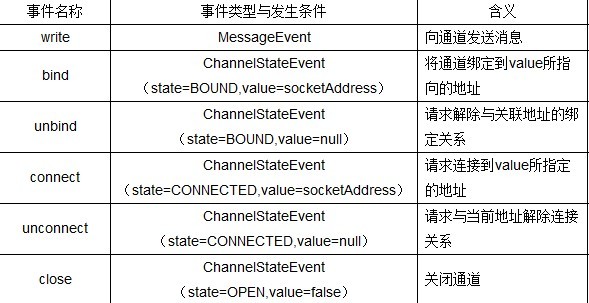浅析Netty的异步事件驱动(一)
本篇文章着重于浅析一下Netty的事件处理流程,Netty版本为netty-3.6.6.Final。
Netty定义了非常丰富的事件类型,代表了网络交互的各个阶段。并且当各个阶段发生时,触发相应的事件交给pipeline中定义的handler处理。
举个例子,如下一段简单的代码:
ChannelFactory factory =
new NioServerSocketChannelFactory(Executors.newCachedThreadPool(), Executors.newCachedThreadPool());
ServerBootstrap bootstrap = new ServerBootstrap(factory);
bootstrap.setPipelineFactory(new PipelineFactory());
bootstrap.setOption("child.tcpNoDelay", true);
bootstrap.setOption("child.keepAlive", true);
bootstrap.bind(new InetSocketAddress(7080));
Netty中触发事件几乎都是靠Channels类中的几个静态fire函数,因此通过在这些函数中加上Sysout方法,就可以看出这一个简单的bind方法触发了多少事件,如下:
fireChannelOpen(final Channel channel) upstream
bind(final Channel channel, final SocketAddress localAddress) downstream
fireChannelBound(final Channel channel, final SocketAddress localAddress) upstream
由此可见由这几个函数触发了OPEN、BOUND和BIND事件。
Netty中的事件大致可以分为upstream事件和downstream事件。简单的说,upstream事件是内获取外资源时触发的事件如messageReceived等等,而downstream事件则是内向外发送资源时触发的事件如write、connect等等。
与之相对应的,处理upstream事件的是upstreamhandler,处理downstream事件的是downstreamhandler,也有可以处理两类事件的channelhandler。我们可以通过继承handler来实现自己的业务逻辑。
Upstream事件的典型是messageReceived,在Netty中抽象为MessageEvent,即接收到了消息。而downstream事件的典型是write,在Netty中也抽象为MessageEvent,即发送消息。一个比较完整的事件表如下:
upstream事件包括:

downstream事件包括

Netty通过pipeline来存放upstreamhandler和downstreamhandler,在pipeline中添加handler的源代码如下:
public class PipelineFactory implements ChannelPipelineFactory { public ChannelPipeline getPipeline() throws Exception { ChannelPipeline pipeline = Channels.pipeline(); //并不具体处理事件,只是输出相关事件的string pipeline.addLast("1", new UpStreamHandler1()); //单纯的丢弃事件 pipeline.addLast("2", new DiscardServer()); return pipeline; } }
在Netty中,upstreamhandler的处理顺序是从前向后,而downstreamhandler的顺序是从后往前。根本原因是pipeline中维护了一个双向链表,handler的处理顺序不同是因为upstream是从head->tail遍历,而downstream事件是从tail->head遍历。
以DefaultChannelPipeline为例,以下分别是添加handler至链表的代码和访问upstreamhandler的代码
public synchronized void addLast(String name, ChannelHandler handler) { if (name2ctx.isEmpty()) { init(name, handler); } else { checkDuplicateName(name); //一段典型的插入到链表尾部并更新尾指针的代码 DefaultChannelHandlerContext oldTail = tail; DefaultChannelHandlerContext newTail = new DefaultChannelHandlerContext(oldTail, null, name, handler); callBeforeAdd(newTail); oldTail.next = newTail; tail = newTail; name2ctx.put(name, newTail); callAfterAdd(newTail); } }
public void sendUpstream(ChannelEvent e) { //从头部开始遍历,相对的是,downstream则是从尾部开始遍历 DefaultChannelHandlerContext head = getActualUpstreamContext(this.head); if (head == null) { if (logger.isWarnEnabled()) { logger.warn( "The pipeline contains no upstream handlers; discarding: " + e); } return; } sendUpstream(head, e); }
前文已经说过,Netty中通过Channels中的静态方法来触发事件,这些静态函数列举如下:
1.fireChannelOpen;2.fireChannelBound;3.fireChannelConnected等等。
直接来看fireChannelOpen的源码,看看Netty到底是怎么做的。
public static void fireChannelOpen(final Channel channel) { // Notify the parent handler. if (channel.getParent() != null) { fireChildChannelStateChanged(channel.getParent(), channel); } channel.getPipeline().sendUpstream( new UpstreamChannelStateEvent( channel, ChannelState.OPEN, Boolean.TRUE)); }
这个sendUpstream到底是干嘛的了?
void sendUpstream(final DefaultChannelHandlerContext ctx, final ChannelEvent e) { try { //从链表头部开始,取出每个节点中的handler直接对channelevent进行处理 ((ChannelUpstreamHandler) ctx.getHandler()).handleUpstream(ctx, e); } catch (Throwable t) { notifyHandlerException(e, t); } }
然后具体到handler又是怎么处理各个事件的了?以SimpleChannelUpstreamHandler为例,如下:
public void handleUpstream( final ChannelHandlerContext ctx, final ChannelEvent e) throws Exception { //根据事件类型进行不同的处理 if (e instanceof MessageEvent) { messageReceived(ctx, (MessageEvent) e); } else if (e instanceof WriteCompletionEvent) { WriteCompletionEvent evt = (WriteCompletionEvent) e; writeComplete(ctx, evt); } else if (e instanceof ChildChannelStateEvent) { ...... } } public void messageReceived( final ChannelHandlerContext ctx, final MessageEvent e) throws Exception { //直接将事件传至下一个handler进行处理 ctx.sendUpstream(e); }
源码看到现在已经很明显了,在Netty里,pipeline中维护了一个handler的链表。每当事件触发时,就会从双向链表的头部(对于downstream事件则是尾部)开始遍历,这样每个handler都会对事件进行处理。在handler里,可以根据事件类型做相应的处理后传至下一个handler继续处理(甚至可以截断处理链)。
需要注意的是,单次流程是在一个线程中实现的,是串行的。因此如果其中一个handler是阻塞的,就会影响整体的效果。
当然netty也已经提供了解决方案,可以通过继承ExecutionHandler的handler来处理这类耗时的操作。而这么做的原理是什么,请期待下一篇文章。






